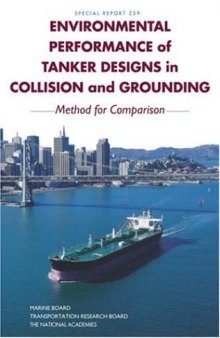 جزییات کتاب
جزییات کتاب
TRB Special Report 259 - Environmental Performance of Tanker Designs in Collision and Grounding: Method for Comparison describes a modeling process for evaluating alternative designs. The process encompasses consideration of the structural deformations from collisions and grounding and the environmental consequences of spills of different sizes, and uses a riskbased approach for comparing designs. Since passage of the Oil Pollution Act (OPA) of 1990 and subsequent decisions of the International Maritime Organization, the world tanker fleet has been evolving to double-hulled designs to reduce the risk of accidental spills. A previous study by the Marine Board, now part of TRB, concluded that the double-hull design had been effective in reducing oil spills (Double-Hull Tanker Legislation: An Assessment of the Oil Pollution Act of 1990, NRC 1998). OPA 1990 was passed because of the 1989 Exxon Valdez oil spill in Prince William Sound. Although the world’s tanker owners have been shifting to double-hull designs, a variety of other hull designs have been proposed that might be as effective and less costly. The U.S. Coast Guard has not been willing to consider such alternatives, in part because of the wording of OPA 1990 and in part because of the difficulty of comparing complex designs.



 دانلود کتاب
دانلود کتاب

 جزییات کتاب
جزییات کتاب





 این کتاب رو مطالعه کردید؟ نظر شما چیست؟
این کتاب رو مطالعه کردید؟ نظر شما چیست؟
